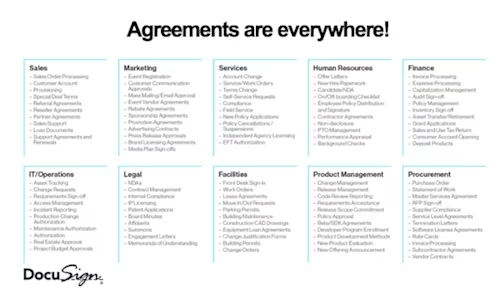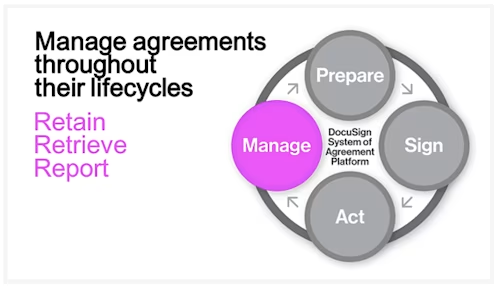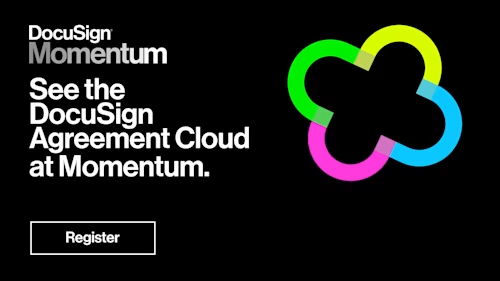
How to streamline your business agreements for better productivity
At Docusign we have a vision to help companies modernise their system of agreement, automating and connecting everything that happens before, during and after processing each business agreement.

At Docusign we have a vision to help companies modernise their system of agreement, automating and connecting everything that happens before, during and after processing each business agreement.
Our aim is to accelerate the way people prepare, sign, execute and manage agreements across all types of businesses and every department. There are thousands, if not tens of thousands of different types of business agreements used every day in the UK. Internal agreements and external ones. Here are just a few!

Every company has a system of agreement, whether they know it or not. However, more often than not that system is broken, full of manual handoffs, poorly managed data and risk. In this blog series, we’re contextualising each of the four stages of a fully digital system of agreement platform. We have previously shared how you can now prepare documents with a high degree of automation before getting them signed quickly and securely. We then discussed how you can act on agreement terms after signing them, including updating records and triggering actions in other systems. Now it’s time to discuss the fourth stage: Manage.
After stepping through the process of coming to agreement, from negotiation to execution, it’s time to store and manage that agreement. The 20th century made a valuable contribution to this effort: in nearly all enterprises, this stage has become digital.
Unfortunately, for many it’s not yet smart. That is to say, after filing a business agreement, companies often forget them—out of sight, out of mind. In doing so, they are missing opportunities to glean insights from them to help review pricing on renewal, for example. This can lead to revenue leakage and it can mean missing out on entitlements. All of that time spent vigorously negotiating terms and conditions for nothing. In truth, when it comes to the Manage stage of their systems of agreement, most companies don’t even have a system.

Manage agreements flexibly
The point is the agreements we store contain opportunities, which we risk losing if we can’t bring them quickly to hand. It can be challenging to find old contracts buried on servers, or on individuals’ hard drives in some cases. Is there anything more frustrating than finding one after the fact and realizing you didn’t take action on clause in your original agreement that would have enriched your client relationship?
This is where Docusign features like secure retention, retrieval and reporting, in addition to analysis of contract content and specialised forms of document maintenance, become really useful. The Docusign Agreement Cloud makes contract management, including taking all of the appropriate actions post signing, much easier.
Managing agreements digitally
The following activities are perfect examples of managing agreements after completion:
Centralise agreements securely, providing the appropriate access rights to each role in the company
Retrieve agreements intelligently when you need them, using AI [link to seal software info] against specific search criteria
Deliver agreements analytics to your business, reporting completion rates, turnaround time, and various other trends
Reuse existing agreements as templates for new agreements.
All of the above becomes possible when you deploy a single, unified system of agreement in the cloud.
See the Docusign Agreement Cloud in action at Momentum Sydney in September
The Australian tour date for the business acceleration event of the year is soon upon us and we can’t wait to show you how to rethink your approach to business agreements with the Docusign Agreement Cloud as well as what is next and new at Docusign. Register today and become part of the Momentum Sydney action on 19 September 2019.


Docusign IAM is the agreement platform your business needs


